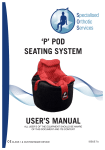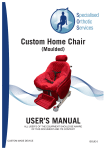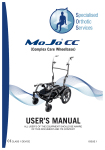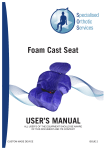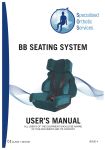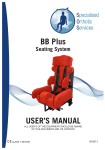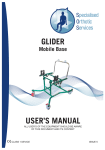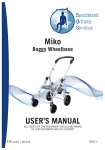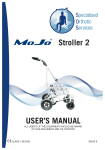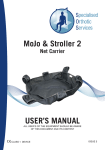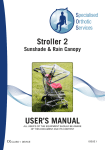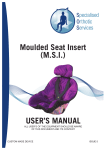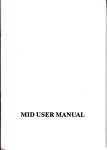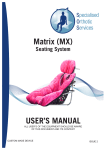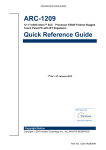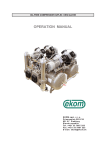Download USER`S MANUAL Toilet/Shower Seat
Transcript
Toilet/Shower Seat USER’S MANUAL ALL USER’S OF THE EQUIPMENT SHOULD BE AWARE OF THIS DOCUMENT AND ITS CONTENT CUSTOM MADE DEVICE ISSUE 2 Index CONTENTS PAGE Index 1 Introduction 2 Clinical Review 2 3 Preparing for Use 3 Safety & Stability 1.0 User’s Guide “Lifting and Handling the Client” 1.1 Lifting and Handling the Client in and out of the Toilet/Shower Seat 4 1.2 Client Straps, Harnesses 4 2.0 User’s Guide “Optional Features” 2.1 Toilet Seat Pan 5 2.2 Adjustable Headrest 6 2.3 Adjustable Footrest 7 2.4 Swing Aside Footrest 8 3.0 User’s Guide “Maintenance of the Toilet/Shower Seat” 3.1 Cleaning the Toilet/Shower Seat 9 3.2 Cleaning the Frame 9 3.3 Client Safety Belts 9 3.4 Visual Inspection 10 “If You Detect a Fault or Breakage” 11 CONTACT DETAILS 1 Backpage TOILET/SHOWER SEAT (Custom Made Device) Introduction • This Users Guide for the custom moulded Toilet/Shower Seat is designed to give guidance on its use and maintenance. • • • • • Each custom moulded Toilet/Shower Seat is manufactured to suit the needs of a particular client and MUST NOT BE USED BY ANYONE ELSE. Each custom moulded Toilet/Shower Seat is designed to give optimum comfort and support for each individual client. It is recommended that during the first days of using the Toilet/Shower Seat carer’s monitor their client’s use of the equipment to make sure that there are no problems and particularly with regard to any pressure problems arising. It is recommended that if pressure issues are observed that the client does not use the equipment until these are resolved. The maintenance and safety instructions described in the manual must be carried out as instructed. Clinical Review • It is recommended that the equipment is reviewed to ensure that it still meets the • needs of the client, it is recommended also that this review is carried out by a suitably qualified person such as a community nurse Therapist/clinician. This is essential to make sure that the equipment remains suitable for the client to use. Users can also contact Specialised Orthotic Services Limited for assistance with Clinical Review of the equipment. (Please see contact details in this manual) 2 Safety & Stability • Always check that the Toilet/Shower seat is not damaged and safe to use before • • • • • • placing the client into the seating system. Inspect and clean the wheels, especially around the brakes periodically to maintain correct operation. Always use the brakes whilst the Toilet/Shower Seat is in position and use. NEVER leave the client in the Toilet/Shower Seat on their own unless the client is physically capable of looking after themselves. Always steer clear of obstacles where possible. When using the equipment never attempt to climb or descend an incline where the surface is rough, wet or slippery. WARNING: Whilst the client is seated in the Toilet/Shower Seat, the attachment of any heavy object to the equipment may have a serious effect on the overall stability of the Toilet/Shower Seat and may place the safety of the client at risk. Preparing for Use • If your Toilet/Shower Seat came with removable legs, please install them as shown • • • below: Push the legs over the spindles on the upper frame (Fig.1) until the leg is fully up against the outer tube on the upper frame. Tighten each leg in place with the locking knob shown (Fig.2), after tightening the legs press down on the upper frame to make sure that the legs are secure and do not buckle. Removal for storage is a reversal of the above procedure. Fig.1 Fig.2 3 USER GUIDE 1.0 1.1. LIFTING & HANDLING THE CLIENT IN & OUT OF THE TOILET/SHOWER SEAT • Most users of Toilet/Shower Seat will need to be • • • • • • hoisted into the equipment. Manually lifting the client is not recommended, however with some clients it may not be possible to hoist them safely by conventional means and in instances such as this you are recommended to carry out a ‘RISK ASSESSMENT’ to assess the risks involved in any such action. It is important that all carers are aware of the Health & Safety guidelines for ‘Lifting and Handling’. Fig.1.1 Before lifting the client make sure all straps are placed out of the Toilet/Shower Seat. This will avoid the straps becoming trapped under the client when seated. When using the hoist, make sure that you follow the hoist manufacturers instructions regarding correct use. On lowering the client into the Toilet/Shower Seat make sure that the client’s hips / pelvis are located as far back as possible into the MSI and that the brakes are applied (Fig.1.1) Leaving the hoist sling in the Toilet/Shower Seat once the client has been placed is not recommended as this could cause discomfort and pressure areas to be generated. However, if any management issues require the sling to be left in situ, then it is recommended that the most appropriate sling be used. If you require further information regarding this, contact your local Wheelchair Service Therapist. Please note, that it is very important that the client is correctly positioned to give maximum comfort and support. 1.2. CLIENT STRAPS / HARNESSES • Secure all straps / harness supplied. Straps and harness must be tightened to work • • • correctly. Client belts fitted to the equipment are designed to be used to assist with safe use of the equipment by the client. Clients must never be left in the equipment without fastening a safety belt in position as this could place the client at risk of falling. Also, make sure that when straps are fastened that these are adjusted correctly as it is also dangerous to have straps too loose. 4 USER GUIDE 2.0 OPTIONAL FEATURES 2.1. TOILET SEAT PAN (if fitted) • Before placing the client in the Toilet Seat make sure that the pan is in place as shown • • (Fig.2.1a) unless the seating system is to be used over a conventional disabled toilet. To empty the contents or cleaning the pan, pull out the tray from underneath the seat using the finger pulls shown (Fig.2.1b), place the pan lid on to the pan (if required) and remove from the tray. After emptying, clean the pan thoroughly and place back into the tray, push the tray back under the seat until it is in position as shown (Fig.2.1a). Fig.2.1a Fig.2.1b 5 2.2. ADJUSTABLE HEADREST (if fitted) • If the Toilet/Shower Seat has been fitted with an adjustable headrest, the headrest • will have been adjusted when the Toilet/Shower Seat was originally supplied. If any adjustments need to be carried out this can be done by releasing the locking knobs and adjusted for height (Fig.2.2a) and depth (Fig.2.2b), re-tighten locking knobs when finished. PLEASE NOTE THAT SOS RECOMMEND THE HEADREST IS USED AT ALL TIMES WHENEVER THE CLIENT IS USING THEIR TOILET/SHOWER SEATING SYSTEM. Fig.2.2a Fig.2.2b 6 2.3. ADJUSTABLE FOOTREST (if fitted) • If the Toilet/Shower Seat has an adjustable footrest, it is important that the feet are • • • • • well supported and the footrest positioned correctly. Make sure that all foot brakes are applied to the wheels (Fig.2.3a). If you have a fixed, height adjustable footrest then release the knobs as shown (Fig,2.3b) and slide the footrest to the height required, Tighten the knobs. If you have a removable footrest then you can remove the footrest by releasing the knobs as shown (Fig.2.3c) and pulling the footrest away from the frame, refitting is a reversal of the procedure. To adjust the height on the removable footrest, release the knob as shown (Fig,2.3d) and slide the footrest to the height required, tighten the knob. DO NOT at any time stand on the footrests as this can result in damage or injury. Fig.2.3a Fig.2.3b Fig.2.3c Fig.2.3d 7 2.4. SWING ASIDE FOOTREST OPERATION (if fitted) • Make sure that all foot brakes are applied to the • • • • • wheels (Fig.2.4a). Hook the footrest assembly on to the location pegs (Fig.2.4b), swing the footrest fully inboard until the catch engages. Foot plates can be swung up (Fig.2.4c) and by pressing the release lever (Fig.2.4d) swung aside to help gain access to the Toilet/Shower Seat. Fig.2.4a The foot plates are height adjustable by releasing the bolt at the rear of the stem (Fig.2.4e) and moving the foot plate up the stem to the desired height then re-tightening the nut. To remove footrests for storage, etc, press the release lever (Fig.2.4d), swing the footrest to the side and lift the footrest assembly off the location pegs. DO NOT at any time stand on the foot plates as this can result in damage or injury. Fig.2.4b Fig.2.4c Fig.2.4d Fig.2.4e 8 USER GUIDE 3.0 MAINTENANCE OF THE TOILET/SHOWER SEAT To make sure that the Toilet/Shower Seat remains satisfactory it is necessary to carry out simple maintenance. 3.1. CLEANING THE TOILET/SHOWER SEAT • During use the Toilet/Shower Seat will require cleaning. This can be done by simply • • • • • applying a warm damp cloth with a mild detergent to the inside surface of the Moulded Seat to remove any soiling and towel dry. If the Moulded Seat remains slightly damp simply leave for a short period at room temperature to dry. The Moulded Seat is manufactured from a closed cell foam which does not absorb water. To clean the outside of the Moulded Seat simply wipe down with a warm damp cloth (a mild detergent may be used) and wipe dry DO NOT PUT THE TOILET/SHOWER SEAT NEXT TO A HOT FIRE OR USE EXCESSIVE HEAT TO DRY AS EXCESSIVE HEAT COULD AFFECT THE SHAPE OF THE SEAT. DO NOT USE SCOURERS OR CAUSTIC SUBSTANCES SUCH AS BLEACH 3.2. CLEANING THE FRAME • The frame of the custom moulded toilet/shower seat is manufactured from stainless • steel and is powder coated to give an easily clean all surface to the equipment. The actual frame of the equipment can be easily cleaned with a damp cloth or a suitable cleaning agent. It is recommended that this is done on a regular basis. 3.3. CLIENT SAFETY BELTS • Make sure all straps are in good working order and that buckles work correctly. • If any show signs of fraying or any buckles are broken or faulty contact your • Wheelchair Service immediately, DO NOT ATTEMPT TO REPAIR. Harnesses may be cleaned by applying a warm damp cloth with a mild detergent, DO NOT USE POLISH. 9 3.4. VISUAL INSPECTION • On a monthly basis it is recommended that the equipment is inspected to check for • • • • • any faults. Look at the tubular frame and make sure that there are no signs ofdamage or distortion. Make sure that the custom moulded seat is securely attached to the supporting framework. Make sure that there are no signs of severe damage to the actual seat itself which could cause discomfort or injury to the client. If any such faults are discovered it is recommended that these are dealt with effectively before using the equipment again. Check all moving parts such as footrests, headrests and other ancillary equipment attached to the seat to make sure that these all work correctly and that there are no damaged parts etc. Once again if any faults are picked up it is recommended that these are resolved before using the equipment again. By carrying out a regular inspection of the equipment you will be ensuring that the equipment remains in good condition for safe use by the client. 10 IF YOU DETECT A FAULT OR BREAKAGE 1. IF YOU DETECT A FAULT OR BREAKAGE OF THE EQUIPMENT THEN REPORT THIS IMMEDIATELY. 2. UNDER NO CIRCUMSTANCES ARE ANY MODIFICATIONS / ALTERATIONS TO BE DONE BY ANYONE OTHER THAN SPECIALISED ORTHOTIC SERVICES LTD (see contact details enclosed). 3. TO CONTACT SPECIALISED ORTHOTIC SERVICES LTD PLEASE REFER TO THE INFORMATION INCLUDED IN THIS USER MANUAL. REPAIRS & SERVICE Within the warranty period. All Seating Systems manufactured by Specialised Orthotic Services Ltd. carry a guarantee on the main parts for 12 months, excluding straps which are guaranteed for 3 months, when used normally. If during this period the product becomes defective and needs repair then please contact SOS (please see the end of this users guide for details). You can also contact your local wheelchair service regarding any faults requiring attention. Outside the warranty period. For any goods requiring repair or attention after the guaranteed period, then assessment can be made as to the cost of the work required to effect the repair. On acceptance of this quotation the work will proceed. Misuse or neglect. The repairs necessary resulting from misuse or neglect, whether within the warranty period or not will be charged for. MEDICAL DEVICES DIRECTIVE 93 / 42 EEC Specialised Orthotic Services Ltd. in compliance with the Medical Devices Directive have an obligation to investigate and take corrective action on defective devices. To assist us with this procedure we would appreciate your assistance in meeting this obligation by informing us as soon as possible and make the device available for inspection as soon as possible having become aware of a defect. We are required to notify the Competent Authority of certain types of incidents within 10 to 30 days. As part of our quality system we have established procedures to deal with such incidences and would appreciate your swift notification to us via our telephone, fax or e-mail details at the end of this users manual. 11 NOTES: 12 NOTES: 13 NOTES: 14 If you require further copies of this handout or require further details relating to any of its content, then please contact us (Copyright applies): Units 127/128, Fauld Industrial Park, Tutbury, Staffordshire. DE13 9HS Tel: 0044 (0)1283 520400 Fax: 0044 (0)1283 520401 E-mail: [email protected] Web: www.specialisedorthoticservices.co.uk
















